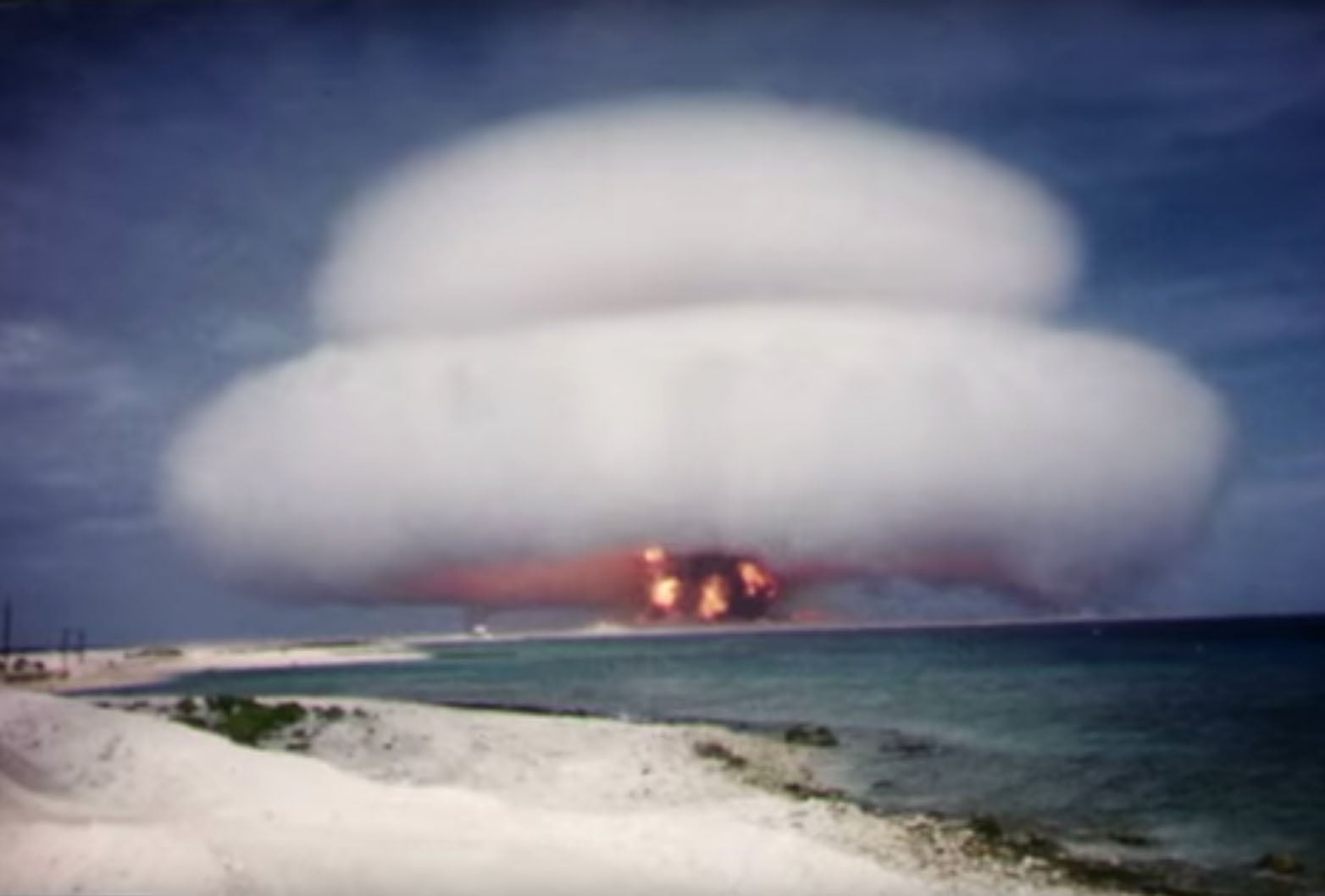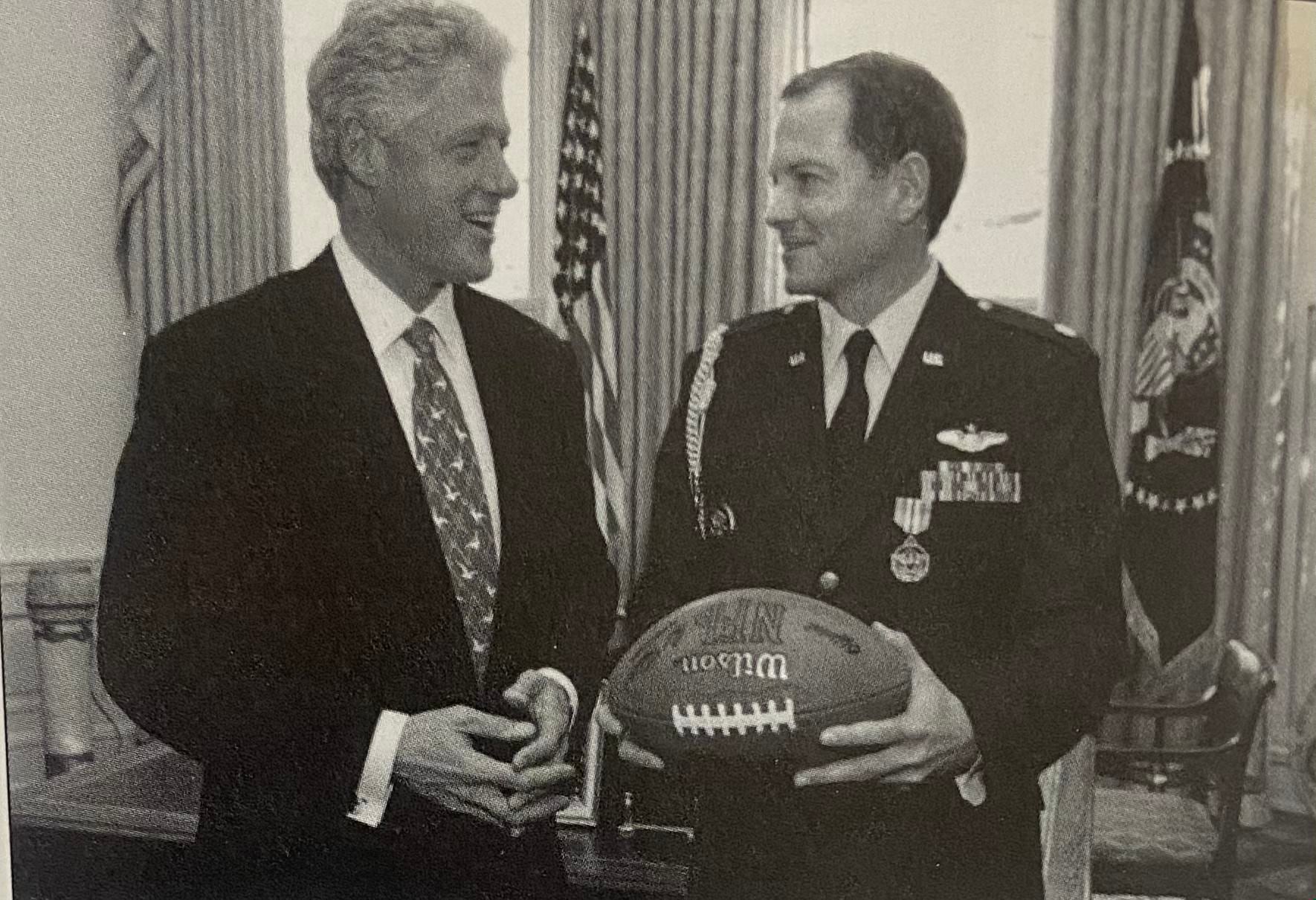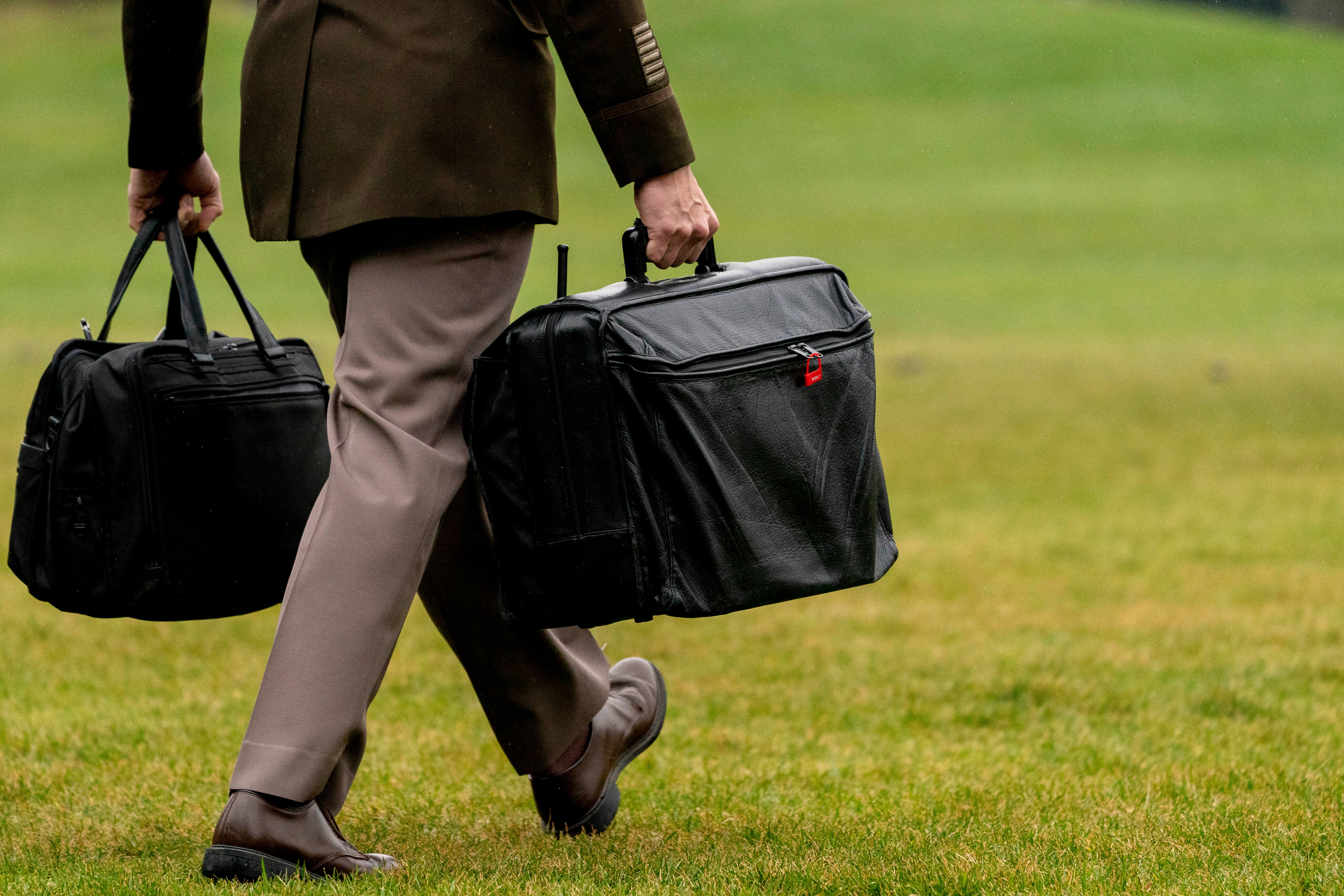The nuclear threat has been dormant in the public’s mind since the end the Cold War. But renewed attention due to the wild success of the film “Oppenheimer’' and rising tensions with Russia and China has brought the so-called nuclear football, the activation device for the U.S. arsenal, back into view.
The sighting of a military aide handling the football, closely following President Joe Biden as he exited a meeting with the United Kingdom’s prime minister on July 10, the day before the NATO summit during which the war in Ukraine was discussed, heightened already building tensions between NATO members and Russia.
Russia and the United States respectively lead the nuclear weapons race, both far ahead of the seven other countries that also have nuclear weapons, according to data obtained from the World Population Review.
Out of the nine countries that have nuclear weapons, the U.S., Russia and Pakistan are the only three that have aides following their political leaders with nuclear briefcases. The information that person carries, along with alphanumeric codes the president carries, allows the world’s most powerful political leader to launch Armageddon if needed at any moment.
Despite the contents of the nuclear football remaining somewhat of a mystery for national security concerns, the device itself still conveys a striking message to the U.S. adversaries, reminding them of the massive defense capabilities it can activate amidst heightened nuclear tensions, said Christopher Karns, former 341st Mission Support Group commander.

The nuclear football was not always what is today. Over time, the briefcase has had drastic changes to its contents, causing speculation to arise over its morality.
A history of the nuclear football
Following the creation and use of the atomic bomb in the 1940s, a story that “Oppenheimer” deeply explored, then President Dwight D. Eisenhower feared the U.S. would be helpless against a nuclear assault. In the late 1950s, he directed a military aide to carry a bag containing documents that would allow the president to communicate an action plan with military headquarters across the country whenever he left Washington.
Eisenhower’s initial satchel included emergency action documents which would help the president regain control of United States actions if a nuclear attack was launched by another country.
“In the event of a nuclear attack, the president could basically seize control of the government and suspend habeas corpus and do all sorts of other things that he wouldn’t be allowed to do in peacetime and wouldn’t be constitutional, but would nevertheless, let him run the government on an emergency basis,” Stephen Schwartz, a nonresident senior fellow at the Bulletin for Atomic Scientists, an organization that aims to inform the public about man-made threats to humanity, told Military Times.
Eisenhower transferred the satchel to his successor, President John F. Kennedy, who changed it over time, as he wanted blueprints for an alternative solution to the all-or-nothing nuclear war strategy of the time.

Former President Jimmy Carter trimmed down the football’s contents, knowing that if the situation arose in which he would have to use the football, he’s have just minutes to act.
Legal concerns about the documents within the football drove revisions during the Carter and Reagan Administrations. By the late 1980s, the documents inside the nuclear football had been completely updated for the first time since Kennedy, said former military aide Buzz Patterson, who handled the football during the Clinton Administration.
“It was pretty much the same football when Carter assumed office that JFK had had and it was outdated,” Patterson said in an interview with Military Times. “They did a couple of modernizations. They went back and looked at the war plans [and] the president’s emergency documents and they realized that some of the stuff is pretty old.”
Despite changes and modernizations throughout history, Karns believes the football is still a strong symbolic message to foes of the United States.
“The availability of this capability serves as a valuable deterrent to those considering harm to the United States,” Karns, who led the 341st Mission Support Group in their mission to prepare expeditionary combat support forces to operations around the world, wrote in a text response to Military Times.
Common misconceptions
Russia and Pakistan both have similar nuclear briefcases. Unlike the U.S., which clouds the nuclear football with mystery, Russia unveiled the contents of that country’s nuclear briefcase on television in 2019 .
As Russian television showed in 2019, the briefcase held actual buttons to launch a nuclear attack, a flash card with codes on it and a keypad of sorts to enter numerical instructions. The contents have not been shown since, however, an aide still follows Putin around will it regularly.
Press spotted an aide carrying Putin’s nuclear briefcase, called the “Cheget,” when he arrived at the Red Square Victory Parade in May. Putin then gave a speech, blaming Ukraine for the war and citing Russian casualties, further increasing tensions among nations.
The U.S. actually has three footballs — one for the president, one for the vice president and one for the designated survivor
The vice president is offered a personal squad of military aides to carry a backup football, but can refuse the satchel, as then Vice President Lyndon B. Johnson did. Most vice presidents do not reject the football, Schwartz said, as it’s crucial for national security in cases of presidential death or if the commander-in-chief is unable to perform his or her duties.
Patterson said that when Clinton severely injured his knee, there were discussions over whether they needed to make Gore’s backup satchel the main one.
“There was a conversation between myself and one of the VP’s military aides, and my concern was if we put Clinton under [anesthesia], then Gore has to have [control of] the football for however long it takes, but we never ended up having to do that,” Patterson said.
Former Vice President Mike Pence was seen at the January 6 insurrection being followed by a military aide holding the satchel.
The satchel is not all that is required to trigger nuclear weapons in times of crisis. A card with authentication codes, the Sealed Authenticator System, also dubbed the “biscuit” which doesn’t have real launch codes but can verify the president’s identity, is supposed to be always carried by the president.
Ballistic missile submarine crews use the alphanumeric codes on plastic cards to authenticate a nuclear launch order from U.S. Strategic Command, Schwartz said. Those cards were at one point nicknamed SAS cookies because they were in a foil-like wrapper, like cookies. The cookie term later became the “biscuit.”
“The president does not have the launch codes,” Schwartz said. “No president has had launch codes. So, the president can’t physically turn keys or push buttons to do anything, he’s relying on a whole chain of people, hundreds of people down the chain of command to transmit the orders and do all of that.”
The National Security Agency generates identification codes for the president to use to authenticate their identity with the National Military Command Center if they want to activate a nuclear defense, Schwartz said.
The activation process begins with an alphanumeric challenge response code from a National Military Command Center officer to the president. The president would then read their identification code, stored on the biscuit, through a secure communication device in the football. If correct, the president chooses an action plan and attack orders are relayed to all involved in the chosen nuclear defense strategy, including intercontinental ballistic missile operators, submarines and bombers, Schwartz said.
Lost biscuit never found
There have been circumstances throughout history when the president was separated from the biscuit, such as when then President Reagan was shot in 1981 and hospital workers stripped him down to save his life, tossing the biscuit into a hospital bag amid the pandemonium.
“[Clinton] lost them forever,” Patterson said. “We never did find them. I was the guy that was with him when he confessed that he had lost them. When I pressed him on it, and I said ‘Okay, sir, how long’s it been since you’ve seen them? Where’s the last place you saw them?’ Typical stuff you ask when somebody’s lost something. And, he said he couldn’t recall. And at one point, he said it could have been up to three or four months [since he’d seen them].”
Patterson claims that Clinton confessed he lost the codes the same morning the Monica Lewinsky sex scandal hit the press.
“The thing about the military aides is we are right around the president, but we’re not always with the president in terms of being in the same room,” Patterson said.
Ethical ramifications
The job of carrying the nuclear football can be burdensome, and not only because it weighs about 45 pounds. Patterson says that the psychological impact of holding such monumental power influences the handler.
“It’s not an easy job,” Patterson said. “It can result in tremendous casualties and the loss of life, livelihoods, cities, homes and all that kind of stuff. I think we all just knew that we were there to be a tool that [could be used], but we didn’t necessarily have to.”
The White House and Department of Defense collaborate to select nuclear football handler candidates. Patterson said that he was one of six Air Force members flown out to Washington for background checks and interviews. Once selected, Patterson immediately flew back to Northern California, sold his home and moved into the White House.
Patterson served for the usual two years, representing the Air Force’s nuclear football handler, alongside a team of military aide’s from other branches.
No specific mental health test was necessary for the role, Patterson said, instead candidates were appointed to the position after passing a security clearance. Schwartz said everyone who works with the president or vice president must pass a screening called “Yankee White.”
“They’re subjected to the personnel reliability program, just like everybody else who works with or around nuclear weapons,” Schwartz said. “Except, of course, for the president, who isn’t subject to anything.”
Schwartz said that most presidents avoid acknowledging the football due to unease.
“[Their inauguration briefing is] the first and last time most presidents think about this,” Schwartz said. “Most of them find it off putting [and] disturbing, you know, to be reminded that they have this power. So they just generally do not think about it.”
While the president has the power to activate it, the military aide is tasked with ensuring that the president is of sound mind before they were to activate the nuclear football.
Patterson recalled grappling over how he would refuse the president’s command to launch nuclear weapons if he believed they were not of sound mind and body.
“And I told myself internally many times ‘If I think he’s coming across as nuts, I don’t think I can participate in this,’” Patterson said. “And so that’s how I rationalized it to myself, and I think a lot of the other aides thought the same kind of thing.”
When then President Trump was in office, some media outlets questioned his sanity, Schwartz said.
“So even if the president went completely bonkers and wanted to launch a nuclear attack, he can’t physically do anything,” Schwartz said. “If he was mentally deranged, people would have a responsibility not to follow those orders, although legally they’re supposed to. So, there’s this kind of gray area there about what you would do, which was tested during the Trump Administration.”
Federal prosecutors lodged an indictment against Trump, alleging he took boxes of classified documents with him as he was leaving office, including documents with information about nuclear programs, defense and weapons.
President Biden’s mental fitness has been debated, 43% of Americans said they believe Biden and Trump are both too old to be president again, a Washington Post-ABC News poll found.
This leaves the military aides tasked with handling the football in charge of what Karn’s believes is the final defense and symbol to prevent a nuclear attack.
“The nuclear enterprise is the ultimate insurance policy for the nation,” Karns said. “If a situation or scenario ever developed where nuclear capabilities were considered, it would impact all of DoD and [the] whole of government in some capacity.”
C4ISRNET Senior Reporter Colin Demarest contributed to this article.
*CORRECTION: This article has been updated, deleting references to the origin of the term “football,” adding information on the term “biscuit,” accurately reflecting the number of nuclear footballs as three and correctly identifying what the president carries as part of the nuclear order process.
Georgina DiNardo is an editorial fellow for Military Times and Defense News and a recent graduate of American University, specializing in journalism, psychology, and photography in Washington, D.C.




